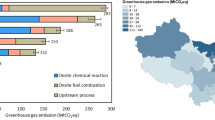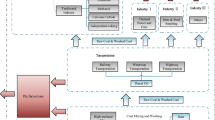Abstract
China’s fossil energy is characterized by an abundance of coal and a relative lack of oil and natural gas. Developing a strategy in which coal can replace oil and natural gas is, therefore, a necessary and practical approach to easing the excessive external dependence on oil and natural gas. Based on the perspective of energy security, this paper proposes a technical framework for defining the substitution of oil and natural gas with coal in China. In this framework, three substitution classifications and 11 industrialized technical routes are reviewed. Then, three scenarios (namely, the cautious scenario, baseline scenario, and positive scenario) are developed to estimate the potential of this strategy for 2020 and 2030. The results indicate that oil and natural gas replaced by coal will reach 67 to 81 Mt and 8.7 to 14.3 Gm3 in 2020 and reach 93 to 138 Mt and 32.3 to 47.3 Gm3 in 2030, respectively. By implementing this strategy, China’s external dependence on oil, natural gas, and primary energy is expected to be curbed at approximately 70%, 40%, and 20% by 2030, respectively. This paper also demonstrates how coal, as a substitute for oil and natural gas, can contribute to carbon and pollution reduction and economic cost savings. It suggests a new direction for the development of the global coal industry and provides a crucial reference for energy transformation in China and other countries with similar energy situations.
Similar content being viewed by others
References
BP. BP Statistical Review of World Energy 2019. London: BP, 2019
Xie K C. Study on China’s Coal Development and Utilization Strategy for Cleanliness, Efficiency and Sustainability. Beijing: Science Press, 2014 (in Chinese)
National Bureau of Statistics. China Statistical Yearbook 2018. Beijing: China Statistics Press, 2018
China National Coal Association. Annual Report on the Development of China’s Coal Industry 2017. Beijing: China National Coal Association, 2018 (in Chinese)
Xie K C, Li W Y, Zhao W. Coal chemical industry and its sustainable develop in China. Energy, 2010, 35(11): 4349–4355
Kong Z Y, Dong X C, Jiang Q Z. The net energy impact of substituting imported oil with coal-to-liquid in China. Journal of Cleaner Production, 2018, 198: 80–90
International Energy Agency. Global EV Outlook 2018. Paris: International Energy Agency, 2018
Liao X W, Chai L, Pang Z Q. Water resource impacts of future electric vehicle development in China. Journal of Cleaner Production, 2018, 205: 987–994
Jiao J L, Zuo F F, Li L L, Yuan H X, Li J J. Estimation of China’s alternative policies of automotive fuels–a perspective of oil dependence. Journal of Cleaner Production, 2017, 161: 698–707
Xie C P, Hawkes A D. Estimation of inter-fuel substitution possibilities in China’s transport industry using ridge regression. Energy, 2015, 88: 260–267
Lin B Q, Wesseh P K Jr. Estimates of inter-fuel substitution possibilities in Chinese chemical industry. Energy Economics, 2013, 40: 560–568
Smyth R, Kumar Narayan P, Shi H. Inter-fuel substitution in the Chinese iron and steel sector. International Journal of Production Economics, 2012, 139(2): 525–532
Zhang Y, Yuan Z W, Margni M, Bulle C, Hua H, Jiang S Y, Liu X W. Intensive carbon dioxide emission of coal chemical industry in China. Applied Energy, 2019, 236: 540–550
International Energy Agency. World Energy Outlook–2017 Special Report: China. Beijing: Petroleum Industry Press, 2017 (in Chinese)
BP. BP Energy Outlook 2019. London: BP, 2019
National Bureau of Statistics. China Energy Statistical Yearbook 2017. Beijing: China Statistics Press, 2017
Zhang L Y, Shen Q, Wang M Q, Sun N N, Wei W, Lei Y, Wang Y J. Driving factors and predictions of CO2 emission in China’s chemical industry. Journal of Cleaner Production, 2019, 210: 1131–1140
Lee D Y, Elgowainy A, Dai Q. Life cycle greenhouse gas emissions of hydrogen fuel production from chlor-alkali processes in the United States. Applied Energy, 2018, 217: 467–479
National Energy Administration. The 13th Five-Year Plan for the Demonstration of Coal Deep-Processing Industry. Beijing: National Energy Administration, 2017 (in Chinese)
National Development and Reform Commission, Ministry of Industry and Information Technology. Plan for the Innovative Development of the Modern Coal Chemical Industry. Beijing: Ministry of Industry and Information Technology, 2017 (in Chinese)
National Development and Reform Commission, National Energy Administration. The 13th Five-Year Plan for Electricity Development. Beijing: National Development and Reform Commission, 2016 (in Chinese)
Du Z L, Lin B Q, Guan C X. Development path of electric vehicles in China under environmental and energy security constraints. Resources, Conservation and Recycling, 2019, 143: 17–26
China Electricity Council. 2017 National Electricity Industry Statistics Data. Beijing: China Electricity Council, 2018 (in Chinese)
National Development and Reform Commission, National Energy Administration. The 13th Five-Year Plan for Energy Development. Beijing: National Development and Reform Commission, 2016 (in Chinese)
National Development and Reform Commission, National Energy Administration. The Revolution Strategy in Energy Production and Consumption (2016–2030). Beijing: National Development and Reform Commission, 2016 (in Chinese)
Chen H, Chen W Y. Carbon mitigation of China’s building sector on city-level: pathway and policy implications by a low-carbon province case study. Journal of Cleaner Production, 2019, 224: 207–217
Huang Y, Yi Q, Kang J X, Zhang Y G, Li W Y, Feng J, Xie K C. Investigation and optimization analysis on deployment of China coal chemical industry under carbon emission constraints. Applied Energy, 2019, 254: 113684
Li J J, Zhang Y L, Tian Y J, ChengW J, Yang J D, Xu D P, Wang Y G, Xie K C, Ku A Y. Reduction of carbon emissions from China’s coal-fired power industry: insights from the province-level data. Journal of Cleaner Production, 2020, 242: 118518
Tang L, Qu J B, Mi Z F, Bo X, Chang X Y, Anadon L D, Wang S Y, Xue X D, Li S B, Wang X, Zhao X H. Substantial emission reductions from Chinese power plants after the introduction of ultralow emissions standards. Nature Energy, 2019, 4(11): 929–938
Xie K C. Strategy study on the development of China’s advanced coal to chemicals industry in accordance with China’s Energy System. Journal of China Coal Society, 2019, in press (in Chinese)
U.S. Energy Information Administration. Annual Energy Outlook 2019 with Projections to 2050. Washington, DC: U.S. Energy Information Administration, 2019
Orsi F, Muratori M, Rocco M, Colombo E, Rizzoni G. A multidimensional well-to-wheels analysis of passenger vehicles in different regions: primary energy consumption, CO2 emissions, and economic cost. Applied Energy, 2016, 169: 197–209
Zhu L J, Wang P Z, Zhang Q. Indirect network effects in China’s electric vehicle diffusion under phasing out subsidies. Applied Energy, 2019, 251: 113350
Xi J P. Secure a Decisive Victory in Building a Moderately Prosperous Society in All Respects and Strive for the Great Success of Socialism with Chinese Characteristics for a New Era. Delivered at the 19th National Congress of the Communist Party of China, 2017
Chen X M, Liang Q M, Liu L C, Wang C, Xue M M. Critical structural adjustment for controlling China’s coal demand. Journal of Cleaner Production, 2019, 235: 317–327
Chen H, Chen W Y. Potential impacts of coal substitution policy on regional air pollutants and carbon emission reductions for China’s building sector during the 13th Five-Year Plan period. Energy Policy, 2019, 131: 281–294
Niu D X, Song Z Y, Xiao X L. Electric power substitution for coal in China: status quo and SWOT analysis. Renewable & Sustainable Energy Reviews, 2017, 70: 610–622
Ministry of Industry and Information Technology. Adjustment and Upgrading Plan for Iron and Steel Industry (2016–2020). Beijing: Ministry of Industry and Information Technology, 2016 (in Chinese)
Ministry of Industry and Information Technology. Development Plan for Building Materials Industry (2016–2020). Beijing: Ministry of Industry and Information Technology, 2016 (in Chinese)
Jiao F, Li J J, Pan X L, Xiao J P, Li H B, Ma H, Wei M M, Pan Y, Zhou Z Y, Li M R, Miao S, Li J, Zhu Y F, Xiao D, He T, Yang J H, Qi F, Fu Q, Bao X H. Selective conversion of syngas to light olefins. Science, 2016, 351(6277): 1065–1068
Acknowledgements
This work was supported by the Major Project of the Chinese Academy of Engineering, Optimization Study on China’s Energy Structure with Carbon Constraint (Grant No: 2016-ZD-07) and the Project of the China Knowledge Centre for Engineering Sciences and Technology in Chinese Academy of Engineering, Professional Knowledge Service System for Energy (Grant No. CKCEST-2019-2-6).
Author information
Authors and Affiliations
Corresponding author
Rights and permissions
About this article
Cite this article
Li, J., Tian, Y., Yan, X. et al. Approach and potential of replacing oil and natural gas with coal in China. Front. Energy 14, 419–431 (2020). https://doi.org/10.1007/s11708-020-0802-0
Received:
Accepted:
Published:
Issue Date:
DOI: https://doi.org/10.1007/s11708-020-0802-0




